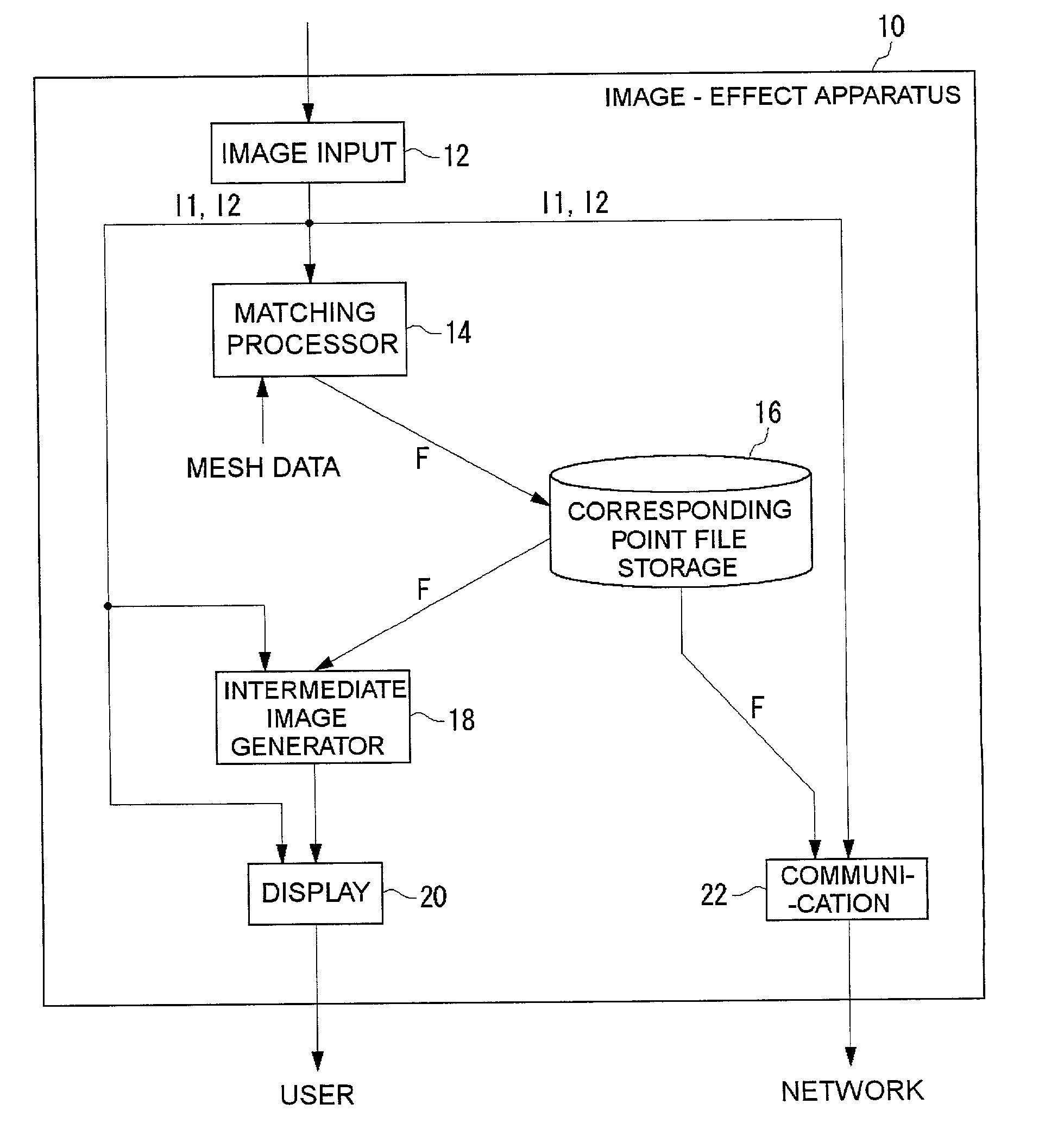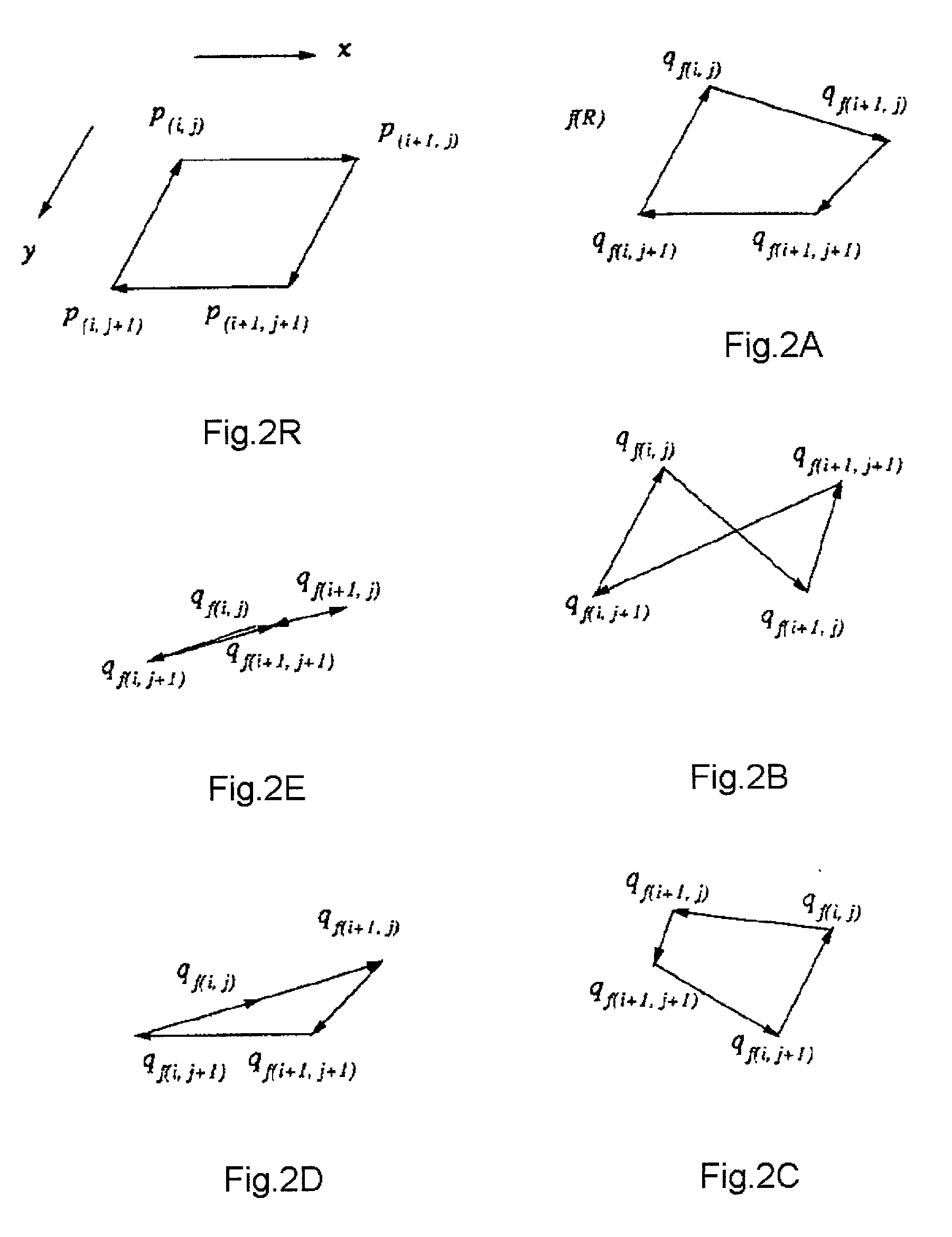Image-effect method and image interpolation method
a technology of interpolation and image, applied in the field of digital image effect and interpolation techniques, can solve the problems that the barrier between broadcasting and communication has been quickly beginning to disappear, and achieve the effect of high data compression and improved quality
- Summary
- Abstract
- Description
- Claims
- Application Information
AI Technical Summary
Benefits of technology
Problems solved by technology
Method used
Image
Examples
embodiment 1
[0297]FIG. 18 shows a first image I1 and a second image I2, where certain pixels p1(x1, Y1) and P2(x2, Y2) correspond therebetween. The correspondence of these pixels may be obtained using the base technology.
[0298]Referring to FIG. 19, when a mesh is provided on the first image I1, a corresponding polygon mesh can be generated on the second image I2. Now, a polygon R1 of interest on the first image I1 is determined by four lattice points A, B, C and D. Let this polygon R1 be called a “source polygon.” As has been shown in FIG. 18, these lattice points A, B, C and D have respectively corresponding points A′, B′, C′ and D′ on the second image I2, and a polygon R2 formed thus by the corresponding points is called a “destination polygon.” In a particular case, the source polygon may be a rectangle while the destination polygon may be a quadrilateral. In the base technology a correspondence relation between images is described pixel-by-pixel, however, according to this embodiment, the c...
embodiment 2
[0310]The image-effect apparatus described in the first embodiment can be utilized for commodity presentation in electronic commerce. The apparatus according to the second embodiment (hereinafter referred to as “a commodity showing apparatus”) uses two adjacent images (i.e. photographs or the like) of a commodity taken from different angles as the first image I1 and the second image I2, and smoothly interpolates between these images so as to display the commodity to a user. In particular, if photographs taken from different angles of every 10 degrees around the commodity are interpolated sequentially, a smooth 360-degree revolving image can be obtained. Conventionally, such a smooth revolving image of the commodity would require the photographs to be taken from different angles of every 1 or 2 degrees, however, when the technique described in the first embodiment is utilized, the difference of the angles can be as much as 10 to 20 degrees.
[0311]Differing from the first embodiment, t...
embodiment 3
[0320]The generation of intermediate images provides opportunities for various image-effect functions. Although image effects are mentioned as a generalization above, the following provides further details on image effects. Some examples of such image-effect functions are as follows.
[0321]Two adjacent images out of a plurality of related images are chosen as the first and second images, and an intermediate image or images between these images are generated and displayed. Thereafter, other adjacent images, taken in order, are chosen as the first and second images and an intermediate image or images therebetween is generated. For example, using images S, T, U whose viewpoints are slightly different, intermediate images between the images S and T are first generated and intermediate images between the images T and U are next generated so that a sequence of images can be continuously displayed. Namely, when many discrete images with different viewpoints are sequentially interpolated and...
PUM
 Login to View More
Login to View More Abstract
Description
Claims
Application Information
 Login to View More
Login to View More - R&D
- Intellectual Property
- Life Sciences
- Materials
- Tech Scout
- Unparalleled Data Quality
- Higher Quality Content
- 60% Fewer Hallucinations
Browse by: Latest US Patents, China's latest patents, Technical Efficacy Thesaurus, Application Domain, Technology Topic, Popular Technical Reports.
© 2025 PatSnap. All rights reserved.Legal|Privacy policy|Modern Slavery Act Transparency Statement|Sitemap|About US| Contact US: help@patsnap.com



